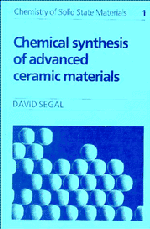Book contents
- Frontmatter
- Contents
- Preface
- Symbols
- 1 Introduction: the variety of ceramic systems
- 2 Conventional routes to ceramics
- 3 Ceramic fabrication
- 4 Sol–gel processing of colloids
- 5 Sol–gel processing of metal–organic compounds
- 6 Non-aqueous liquid-phase reactions
- 7 Polymer Pyrolysis
- 8 Hydrothermal synthesis of ceramic powders
- 9 Gas-phase reactions
- 10 Miscellaneous synthetic routes to ceramic materials
- Appendix: Determination of particle size
- References
- Index
- Frontmatter
- Contents
- Preface
- Symbols
- 1 Introduction: the variety of ceramic systems
- 2 Conventional routes to ceramics
- 3 Ceramic fabrication
- 4 Sol–gel processing of colloids
- 5 Sol–gel processing of metal–organic compounds
- 6 Non-aqueous liquid-phase reactions
- 7 Polymer Pyrolysis
- 8 Hydrothermal synthesis of ceramic powders
- 9 Gas-phase reactions
- 10 Miscellaneous synthetic routes to ceramic materials
- Appendix: Determination of particle size
- References
- Index
Summary
Introduction
Solid ceramic bodies are generally produced by using the process of powder compaction followed by firing at high temperature. Sintering or densification occurs during this heat treatment and is associated with joining together of particles, volume reduction, decrease in porosity and increase in grain size. The phase distribution or microstructure within the ceramic is developed during sintering and fabrication techniques used for shaping ceramics are described in this chapter. The aim of these techniques is to produce microstructures suitable for particular applications. Hence a fine-grained distribution is required for strength. Controlled grain size is necessary where optical properties such as translucency are required. Strength and toughness of ceramic systems are also discussed here with particular reference to the role of powder preparation on the strength of ceramics.
Solid-state sintering
The driving force for sintering is reduction in surface free energy associated with a decrease of surface area in powder compacts due to removal of solid–vapour interfaces. Vapour-phase nucleation is described in chapter 9 by using the Kelvin equation (9.1), which is also applicable to mass-transport processes in a consolidated powder (Kingery, 1983). The vapour-pressure difference across a curved interface can enhance evaporation from particle surfaces and condensation at the neck between two particles, particularly for particle diameters of several micrometres or less, such as occur in ceramic fabrication. Although this evaporation–condensation process produces changes in pore shape and joins particles together, the centre-to-centre distance between particles remains constant so that shrinkage and densification do not occur.
- Type
- Chapter
- Information
- Chemical Synthesis of Advanced Ceramic Materials , pp. 23 - 32Publisher: Cambridge University PressPrint publication year: 1989
- 1
- Cited by

